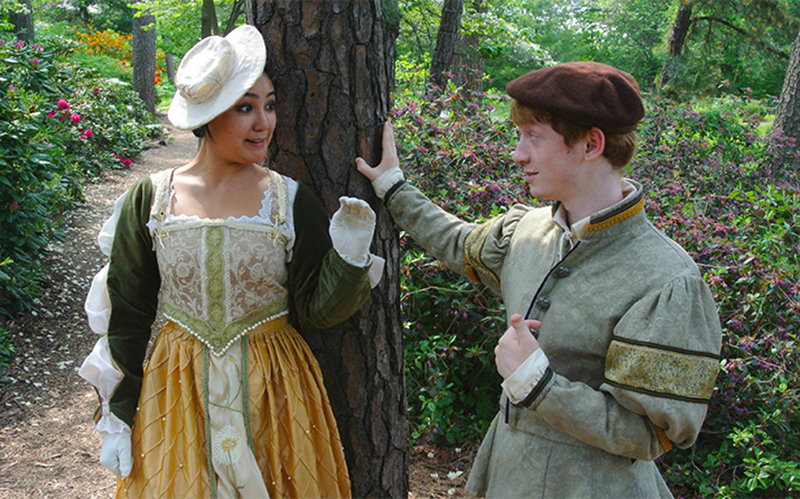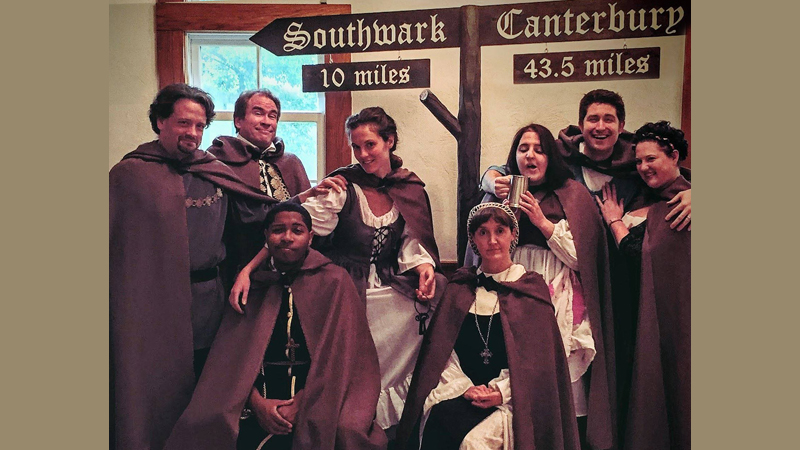Strike Up the Band for the Perfect Summer Night

When I was a kid, my dad and I watched every single episode of the Twilight Zone. My favorite episode was one called "A Stop at Willoughby." It was a simple tale of a harried ad man (because everyone was an ad man in the 1960s) who dreamed of a town called Willoughby that would be a retreat from his stressful, three-martini-lunch world. Instead, Willoughby would have a small downtown, a fishing pond, and space for an outdoor band concert.
"Wow," thought the young suburban girl who had never contemplated downtowns, fishing ponds, or outdoor band concerts. "I would love to live in a place like that!"
When I got to Ann Arbor, I found the downtown and the river almost immediately; however, seeing as how I came to town in winter, discovering the outdoor band took a little more time. Lucky for us all, the Ann Arbor Civic Band has been providing us with an outdoor summer concert series at West Park for over 80 years.
Conductor Bill Gourley leads the volunteer band members for five or six concerts every summer. There is a slight variation on the themes of the concerts, but there is always a children’s concert with a march of the teddy bears and a salute to the military around the Fourth of July. The 501(c)(3) organization is funded by membership dues, sponsorships, and donations.
This year, residents can wander down to West Park on Wednesday nights at 8 pm and enjoy a concert featuring music from movies such as Star Trek or Batman, a tribute to swing music, Broadway show tunes, and the beloved Children’s Concert (bring your bear!).
Being outside at the park and listening to live music is enchanting. People sit on blankets, chairs, or on the grass. Kids run around, dogs lie at the feet of their owners, and the music echoes off the band shell as fireflies light the paths. The fresh smell of the green grass under your feet tickles your nose. The sun might be in your eyes as it sets, but only for a minute. Then everything is lit in the glow of a perfect summer evening.
These are the nights I think of in mid-February, when everything seems to be dead or hibernating, when the trees are bare, when the snow has turned brown and mushy. When it seems like summer will never get here, and it has always been cold, I think of these magical nights and I am happy to live in my own version of Willoughby.
Patti Smith is a special education teacher who lives in Ann Arbor with her husband and cats. She is the author of two books about Ann Arbor, the most recent is a history of the People’s Food Co-op. She wishes she had even an ounce of musical talent so that she could join the Civic Band! Visit her at www.PattiFSmith.com or @TeacherPatti on Twitter.
The Ann Arbor Civic Band performances continue at 8 pm, Wednesdays, July 6, 13, 20, and 27, at the West Park Band Shell in West Park, 7th Street.
Review: The BFG

Fans of Roald Dahl's 1982 children's book The BFG will find that source text replicated lovingly in Steven Spielberg's new film adaptation–occasionally perhaps with even more detail than they wanted.
Spielberg restages Dahl's tale almost beat for beat, as the stubborn orphan Sophie (Ruby Barnhill) is swept away from her orphanage one night by a big friendly giant, or "BFG" (Mark Rylance). The BFG makes an occupation for himself capturing dreams and redistributing them into "human beans'" heads by night, and he takes Sophie back to Giant Country with him for fear she'll expose him to the world. Sophie warms quickly to the plight of the loving but somewhat dimwitted BFG, who is harassed constantly by nine man-eating and considerably larger giants (a voice cast led by Jemaine Clement and Bill Hader). As the giants devour humans by night and plague the BFG by day, Sophie hatches a plan to stop them, requiring the assistance of no less than the Queen of England (Penelope Wilton) herself.
It's a common complaint that cinematic adaptations of books deviate too much from their source material, but there are pitfalls in holding too much reverence for the original text as well. Screenwriter Melissa Mathison, who penned classic family flicks including The Black Stallion, E.T., and The Indian in the Cupboard before her death last year, translates Dahl's material to the screen almost directly. The film thankfully wastes no time revealing its title character and whisking Sophie away with him, but from there it occasionally bogs down. Mathison and Spielberg place Dahl's material on a pedestal and just leave it there to be admired at unnecessary length.
This tendency is persistent throughout the first two-thirds of the movie, most noticeably in an initially lovely but ultimately overlong scene in which the BFG and Sophie collect dreams. The film develops some momentum, and some of its greatest comic energy, when Sophie and the BFG take off for Buckingham Palace, but it takes quite a while to get there.
The two leads are so excellent throughout that you'll wish one of them were more physically present. Barnhill, whose previous filmography includes just six episodes of a British children's TV series, comes off very well here. Not just your average precocious young lead, she plays Sophie with a mature self-assuredness that still has just the right undercurrent of childish vulnerability. Rylance, coming off a well-deserved Best Supporting Actor Oscar win for Spielberg's Bridge of Spies, makes an extremely endearing BFG, gently enunciating the character's goofy malapropisms.
How unfortunate, then, that Rylance's performance is motion-captured and his BFG entirely computer-generated. The character is convincing in certain moments–particularly in close-ups, where the effects team appears to have smartly concentrated its efforts–but surprisingly wooden in others. Given Rylance's physical resemblance to illustrator Quentin Blake's original rendition of the giant, which the film closely mimics, Spielberg's decision to create a CGI giant instead of using more practical filmmaking magic to put Rylance onscreen in the flesh is rather perplexing.
Ultimately, Spielberg and Mathison's heads are basically in the right place when it comes to this material. They understand Dahl's sense of humor and his essential warmth, although they also don't shy away from the brutality that underlies much of his work. They just make the mistake of putting too much effort into bringing Dahl's simple but vibrant story to life, whether lingering too long over minor details or throwing millions of dollars in effects money at creating CGI giants where practical effects would have worked better. In the end, The BFG is certainly not a bad movie; it's often charming and sometimes even delightful in its own right. But its humbler source material tops it in both those departments–and you can probably read it in less time.
Patrick Dunn is an Ann Arbor-based freelance writer whose work appears regularly in Pulp, the Detroit News, the Ann Arbor Observer, and other local publications. If he were a giant, he would certainly choose to eat snozzcumbers rather than small children.
The BFG opens in theaters on July 1 .
Review: Zilka Joseph Poetry at Ann Arbor Book Festival

Poetry is a democratic form of art; perhaps one of the most accessible genres of writing as it’s meant not only to be read, but heard and performed. The echoes of poetic language are all around us from the piece of a song you catch as you walk by an open cafe door to the movement of a conversation between strangers. Despite poetry’s underlying prevalence in our lives, one of the least expected venues for poetry may just be a sports bar.
Still, on Saturday, June 18th, The Arena in downtown Ann Arbor opened its doors to the Ann Arbor Book Festival Book Crawl and three local writers, including poet Zilka Joseph. A long-time Ann Arbor resident, Zilka has been nominated twice for a Pushcart prize and her poems have appeared in many publications from Poetry (forthcoming–look for it later this year) to the Kenyon Review Online. Her work was honored through several awards including a Hopwood, the Elsie Choy Lee Scholarship from the Center for Education of Women, and a Zell Fellowship from the University of Michigan. Against the backdrop of Michigan football memorabilia and muted ESPN highlight reels, Zilka read from her recent collection, Sharp Blue Search of Flame.

This collection is remarkable with its breadth and enchanting language, encapsulating the boundaries--artificial and real--of life in India and the United States. All the while, Zilka’s poems search for something larger, something beyond us and all around us. This may be spiritual or it may be the commonality of human experience. From guiding the reader/listener on an internal journey to mapping identity in a complex world, Zilka brings the cyclical nature of life and self-discovery to the forefront of her work.
This sentiment of self-reformation resonates in poems like Birds in a Blizzard where Zilka writes “your ancestors are wanderers,” or in Child of Churning Water where she asks “Who shall I be now? Where can I perch?” Zilka’s interest in rebirth extends outward to broader stories of mythology, cycles, and origin. With Apples and Oranges, the Adam and Eve story is reframed to challenge the common narrative of this tale.
In between her poems, Zilka offered insight into her creative process and the emotional source of her writing. “I feel as though I’ve lived many lives,” she told the audience. “We always find ways to reinvent ourselves even from our darkest moments.” The multitudes of Zilka’s lives seem to lend themselves to the deep introspection present on the page.
As she went on to read What Burns (Who Will Remember), a poem about the rape and murder of Jyoti Singh, a young woman in India whose death sparked international protest, the tone of the room changed to one of solace. A police officer in the audience was moved by this piece and pledged to read more about the story so as to better serve the community he works in, demonstrating the social value of reading poetry in public.
Art is ultimately a celebration of the unexpected, observed moments that are truly human and full of life. Hearing such beautiful poems read in an unexpected setting reminded me of the boundaries we often create in our own environments, and the importance of seeking uncommon moments of beauty.
Juliana Roth is a writer currently living in Ann Arbor whose poetry, essays and fiction have appeared in The Establishment, Irish Pages, Bear River Review, DIN Magazine, and other publications.
Visit Zilka Joseph's website for more info on her and her work. The Ann Arbor Book Festival is an annual event. Check their website for next year's dates and additional events.
Preview: Bruce Hornsby & the Noisemakers, A2SF on 6/30

Bruce Hornsby is still making beautiful noise. If you liked The Way It Is back in the 1980s, you’ll be amazed by what he’s done since then. His latest touring iteration as the group of jam/pop/jazz/grass/rock fusionists, Bruce Hornsby & The Noisemakers, and their just-released album Rehab Reunion, have me vibrating with anticipation for their appearance Thursday night at the Power Center on the University of Michigan campus.
In the 30 years since Hornsby owned the airwaves and was named Best New Artist at the 1986 Grammy Awards, the other “BRUUUCE!” has enriched and reinvented his music in a series of layers that can be studied like rock strata, each layer deepening the impact and artistry of his career.
The strata from bottom up:
• Take a rock-solid improvisational piano technique honed at Berklee College of Music, steeped in surprising jazz phrasing and syncopation.
• Throw in a banjo, perhaps Bela Fleck. Bring bluegrass themes to the fore, and then aft as pop/jazz bounds forward.
• Add some horns. Organ. Extra percussion. Mandolin. More banjo!
• Call up Jerry Garcia and sit in at keyboard for the Grateful Dead. Only 100 shows or so.
• Call up Ricky Skaggs and turn your most iconic top-40 songs into funky bluegrass improvisational explosions.
• Collaborate with the likes of Bob Weir, Don Henley, Sting, Elton John, Eric Clapton, Pat Metheny, The Nitty Gritty Dirt Band, Trey Anastasio, Mickey Hart, Bob Dylan, Railroad Earth, Crosby, Stills & Nash and Bonnie Raitt to expand the repertoire. (Many sub-layers here!)
• Continue to tour and record off and on for the last 15 years as Bruce Hornsby and the Noisemakers while continuing to perform and record as another half-dozen personae.
Rehab Reunion is the band's fifth audio release (after their DVD debut Here Come the Noisemakers) and their first release in five years. The music business has turned upside down with the digital revolution, and artists now earn most of their keep on the road. That doesn’t obviate the recordings, which are mostly marvelous, (Hornsby has a habit of walking the improvisational wire without a net) but the real money is on tour.
I used to say that Bruce Hornsby got me through some dark musical times of the mid-80s and early 90s (along with Tom Petty, Huey Lewis and Don Henley), but in truth, Bruce’s multitude of musical styles and collaborations has carried me through every decade since.
Join us Thursday night to discover what stratum Bruce will draw from… likely, all of them.
Don Alles is a marketing consultant, journalist, house concert host and musical wannabee, living in and loving his adopted home, Ann Arbor.
Bruce Hornsby & The Noisemakers will perform Thursday, June 30 at 8pm at the Power Center. Tickets are $20 (students), $35, $40, $45, $50, $55. Visit http://a2sf.org/buy-tickets" or call (734) 764-2538.
Review: Love's Labour's Lost, Shakespeare in the Arb

While watching Shakespeare in the Arb’s Saturday evening production of Love’s Labour’s Lost, which wrapped up its run this past weekend, I realized that it’s kind of the Elizabethan drama ancestor of a famous Seinfeld episode called, “The Contest.”
Why? Because in both stories, four characters make a pledge to each other to suppress sexual desires (and its expression), and in both stories, they fail miserably – and pretty immediately.
Love’s Labour’s Lost, one of Shakespeare’s earliest comedies, begins when Ferdinand, King of Navarre (Will Arnuk), decrees that he and three companions – Lords Berowne (Michael Shapiro), Dumaine (Nicholas Menagan), and Longaville (Jackson Tucker-Meyer) – will dedicate themselves to scholarly study for three years, sleeping little, fasting often, and abstaining from any contact with women, so as to not be distracted.
Shortly after signing the pact, though, Ferdinand’s reminded that the Princess of France (Clare Brennan) is on her way to Navarre, accompanied by three ladies-in-waiting: Rosaline (Amy Robbins), Maria (Rebecca Godwin), and Katherine (Maia Gersten). When the King greets the royal party to explain why they must make camp outside his court, he falls in love with the princess, of course, and his friends become smitten with her companions, leaving the men scrambling to convey their affections to the women while also hiding it from their compatriots.
Shakespeare in the Arb shows are always “traveling” productions, so instead of watching a series of set changes, the audience gets up and moves to a new part of Nichols Arboretum. This is a double-edged sword, of course, because while it gives the players a great variety of natural backdrops within which to play, the logistics of getting a couple hundred audience members from one area of the park to another – separating the ground-sitters up front from the chair-sitters behind – more than a half dozen times can bloat the show’s running time, compromise momentum, and grow unwieldy (audience members at Saturday’s performance seemed to get a smidge grumpier/more impatient with each transplant).
Even so, the unique opportunity to marry classic material with outdoor elements is part of what has made Shakespeare in the Arb a magical, beloved, 16 year old tradition. For watching Ferdinand and his friends hide in the trees as they’re each revealed, one-by-one, to be composing love letters, and seeing the Princess leading her party away, in mourning, far off in the distance as a scene among the men plays out, makes Shakespeare’s text come alive in beautiful, arresting ways.
Not that Love’s Labour’s Lost is among the bard’s best plays – far from it. Like a romantic comedy that doesn’t quite know when to quit throwing obstacles in love’s path, the three hour play drags most heavily in its second half. Once the men confess to each other their love for the women, they decide to abandon the oath and visit the royal party in disguise (according to the text, as Muscovites, but in Kate Mendeloff’s Arb production, they all looked more like The Princess Bride’s Dread Pirate Roberts); but the women get wind of this scheme and play a trick of their own, disguising themselves so that each man professes his love to the wrong woman. And then, when all deceptions have finally been revealed – and it feels like the end is near – the schoolmaster and others present a theatrical pageant, drawing things out further, and the Princess receives news from home that changes everything.
Gersten made the princess a wise, strong and mischievous woman – definitely one of the best, most clearly defined performances of the night – while Robbins’ Rosaline was an ideal, charismatic foil for the equally wily and witty Shapiro. And as the cast’s youngest participant, Elijah Hatcher Kay charmed the socks off the audience as Moth.
Mendeloff incorporates a fun bit of swordplay and dance into the show, and one of her strengths is that her actors always speak Shakespeare’s poetry with a clear sense of meaning and purpose, so that those audience members largely uninitiated in the ways of the bard (including young people) can pretty easily follow the narrative.
So despite the fact that Love’s Labour’s Lost is ultimately the lesser work of a master, Shakespeare in the Arb managed to make its production – which played to many sold out crowds – the occasion for a pretty nice night in the park.
Jenn McKee is a former staff arts reporter for The Ann Arbor News, where she primarily covered theater and film events, and also wrote general features and occasional articles on books and music.
Review: Ann Arbor Art Center's Pop-In

All three floors of the Ann Arbor Art Center pulsed with energy Friday night for this summer's inaugural Pop-In event. While the center's programming is generally eclectic on the whole, the free Pop-In series presents a particularly diverse assortment of art and entertainment in a single night, suitable for all ages but particularly aimed at young adults. This Friday's event, curated by Charlie Reischl, was billed as a "digital takeover" of the art center with a variety of offerings related to electronic arts. While some attractions adhered to that theme more than others, the evening was nonetheless consistently stimulating and entertaining in unexpected ways.
Upon entering the art center, DJ Scout set the mood on the first floor with some laid-back electronic grooves. Ascending to the second floor, attendees were welcomed by members of Kickshaw Theatre, who were recruiting "test subjects" for a short theater piece entitled Technology, In the Flesh. The 15-minute play repeated numerous times throughout the night, as Dr. Tina Burglorgler (Alysia Kolascz) and her assistant Quatthew (Aral Gribble) led audiences through a series of comical "experiments" exploring the differences between our reactions to analog and digital stimuli. In the most entertaining bit, Burglorgler showed the audience several slapstick YouTube videos and then replicated them on Quatthew in some cannily executed bits of stage violence. The differences in audience reaction were striking, as attendees remained mostly straight-faced during the videos but laughed or gasped openly as Burglorgler slammed Quatthew's head into a table and whacked him in the crotch with a baseball bat. The show oversold its point a bit–real-life experiences are consistently more stimulating than digital ones. But it was an amusing, creative second effort from the extremely promising new Kickshaw company, which produced the extraordinary The Electric Baby earlier this year.
Moving up to the third floor, attendees had a wide variety of attractions to explore. Attendees could have a hands-on experience with new technology by experimenting with a sampling of instruments from AADL's music tools collection or with a Wacom digital drawing tablet (under the able guidance of cartoonist Jerzy Drozd). Wandering into an adjacent darkened room, visitors could also take in a variety of unique musical performances, like the improv duo and art project Efflux. Efflux percussionist Jon Taylor and keyboardist Simon Alexander-Adam riffed wildly on their respective instruments while a custom-built program responded to their music in real time with abstract digital images projected on several small cube-shaped screens. Between the duo's inventive improvisation and the hypnotic digital imagery, Efflux presented a surprisingly spellbinding experience.
The highlight of the evening, however, was a concluding musical performance by members of the unconventional international rap performance collective known as the Black Opera. Ann Arbor rapper Jamall Bufford and Detroit rapper Magestik Legend kicked things off with what they described as an "opening set" for the Black Opera, energetically encouraging audience participation throughout. The two departed the stage but then returned, clad in oversized masks, to perform as the Black Opera themselves. The duo blasted through an impassioned set of songs with topics ranging from police violence to overuse of social media to the Flint water crisis. Bufford and Legend changed costumes for each song, ranging from dashikis to ski masks, with striking music videos projected behind them. At the conclusion of their performance, the duo announced that they and their entire audience were now part of the Black Opera. While the audience seemed equally divided between those who were previously aware of the Black Opera and those who were initially puzzled by what they were seeing, by the show's end Bufford and Legend had thoroughly accomplished their goal: drawing the crowd into a kind of critical, but positive, musical social movement.
Pop-In will continue this summer with events on July 22 and August 5. The July event will feature an inversion of this past Friday's theme, with an emphasis on analog music, tools, and art. The August installment will split the difference, focusing on the intersection of technology and creativity in a partnership with the new conference Intermitten. If Friday's Pop-In is any indication, attendees of the two coming events are in for an eye-opening, thought-provoking, and thoroughly entertaining experience.
Patrick Dunn is an Ann Arbor-based freelance writer whose work appears regularly in Pulp, the Detroit News, the Ann Arbor Observer, and other local publications. He would prefer that you neither slam his head into a table nor whack him in the crotch with a baseball bat, even if it would be funnier than watching a YouTube video.
Pop-In will continue this summer with events on July 22 and August 5.
Review: The Penny Seats Theatre Company's Canterbury Tales

We’re all pilgrims, in a sense, finding our way around the hairpin twists and bumps in our life’s path. Maybe this is why Geoffrey Chaucer’s 14th century writings about a group of pilgrims traveling to Sir Thomas Becket’s shrine still endure.
Or it could just be because The Canterbury Tales – adapted for the stage by Lindsay Price, and now being staged (outdoors) by Ann Arbor’s Penny Seats Theatre Company – are often laugh-out-loud funny, and demonstrate that hundreds of years ago, people had many of the same desires and fears that we have have now.
One basic human drive was, and remains, storytelling, which Chaucer’s pilgrims employ as a means of distracting themselves during the journey. For Price’s stage version of Canterbury, the pilgrims have been distilled down from about thirty, in the original Middle English text, to seven: the Pardoner (Brian Baylor), the Miller (Matt Cameron), the Franklin (Dale Dobson), the Cook (Jenna Hinton), the Prioress (Tina Paraventi), the Wife of Bath (Debbie Secord), and the Reeve (Jeff Stringer) – plus an inn’s hostess (Jennifer Sulkowski), who tags along and suggests that the pilgrims compete in a storytelling contest.
I’ll pause a moment here while you Google the definition for “Reeve” and “Franklin,” as I needed to do.
Director Anne Levy stages the production on the walkway in front of the West Park band shell, so patrons sit on blankets or lawn chairs in a tiered, grassy space. (Many brought a picnic dinner, and some snacks and drinks are available for purchase; sunglasses, a hat, and sunscreen are recommended, since the sun can be pretty intense for the show’s first hour.)
Using little more than costume props and small, stackable wooden benches – in a way, Penny Seats’ Canterbury hearkens back to theater at its simplest and most pure – the spirited troupe re-enacts six of Chaucer’s most memorable tales, employing music and small bursts of audience interaction/improv for set changes. And while a couple of the stories feature bawdy sexual situations and crude acts, Price’s adaptation, paired with Levy’s direction, suggest instead of show. (It also makes some textual adjustments, so that the Nun’s Priest’s tale of a rooster and a fox is told instead by the priggish Prioress.)
Levy’s ensemble works together beautifully, occasionally working in contemporary references for fun. (Following the line, “The truth is out there,” there’s a mumbled reference to Agent Scully.) And Price’s choice to have the pilgrims re-enact the tales results in many opportunities for the players to shift accents and personas. Some don’t make sense – a New Yorker? – but they’re not supposed to. The shifts underline the fact that this is all just a bit of silly fun.
Hinton earns big laughs as the self-doubting cook who’s too cowed to tell a story; Secord plays an appropriately bold, unapologetically straight-shooting Wife of Bath (and an even funnier hen); and Stringer, as the touchy Reeve, anchors the production, stepping into many roles with no-holds-barred zest.
With a running time of just over two hours, with one intermission, Canterbury doesn’t exactly feel fleet, despite the cast’s best energy and efforts, so it’s ultimately more pleasant than thrilling. But given the relaxed vibe of the venue, and the quality of the production, there’s no reason why Penny Seats Theater – alongside Shakespeare in the Arb – shouldn’t become yet another beloved outdoor theater tradition in Ann Arbor.
Jenn McKee is a former staff arts reporter for The Ann Arbor News, where she primarily covered theater and film events, and also wrote general features and occasional articles on books and music.
The show runs Thursdays, Fridays, and Saturdays until July 2 in Ann Arbor's West Park. Tickets are available online.
Review: Purple Rose's Morning’s At Seven mines gentle humor in family conflict

Paul Osborne’s Morning’s At Seven treads lightly on themes of personal disappointment, repressed feelings, and unrelieved tension in a small town Midwest.
Osborne’s sympathy for this world out-of-sync is given a respectful and well-performed staging by the Purple Rose Theatre in Chelsea. Osborne, who grew up in Kalamazoo and went on to great success as a playwright and screenwriter, creates gentle comedy from material and settings that William Inge would later turn into steamy drama in Come Back Little Sheba, Picnic and other works.
Osborne’s approach is low-key and knowing and director Michelle Mountain captures that tone and the sometimes bittersweet nature of Osborne’s comedy. The staging also evokes through set, music, and soft lighting the particulars of place and time, 1938.
Morning’s centers around four sisters who live near each other in a small, rural Midwestern town. They are getting up in years, the oldest is 72 and the others are in their 60s. Their ambitions have been small, home centered, but underneath are disappointments never openly expressed.
Cora lives with her husband Theodore, called Thor, and her younger never-married sister Aaronetta Airie. Next door is sister Ida, whose husband Carl has mental-emotional problems. Their son, the well-named Homer, is 40 and has never left home. A few blocks away is Esther. Her husband David is a retired professor who disdains his wife’s family and openly dismisses them as a pack of morons.
The quiet disruption that motivates the play is provided by Homer, who brings home his girlfriend of many years, Myrtle. He visits her in the city but has never introduced her to his family. He’s never asked her to marry him and he’s never moved into the house that his father built for the couple.
Homer suffers from the same doubts and lack of confidence that torture his father. Meanwhile, the house sits empty and Aunt Cora wants it.
What makes this work to some extent is actors who can delve deeply and sympathetically into the motivations, pains, and sly humor of these characters, who in the hands of a lesser playwright and/or a less focused cast could become rube stereotypes ripe for contempt.
At the heart of the play is Aaronetta, the “old maid.” Laural Merlington gives an outstanding performance of this feisty, righteous woman. She captures all of Airie’s contradictions from her warm-heartedness to her suspicions, nervousness, and repressed desires. This is a complex character and Merlington does a fine job of finding all the shadings that make her live as a real person.
Airie’s pain comes from her lifelong love for her brother-in-law Thor. Richard McWilliams makes that affection seem well placed in his performance of a fine, well-centered, decent man. McWilliams captures his warmth, quick empathy and sly sense of humor. Thor is the rock-solid middle American but McWilliams lifts him beyond any easy stereotype as he maneuvers through the most dramatic sections of this comedy. His face and his voice fit exactly who this man is.
Ruth Crawford is Cora, a nervous bundle of a woman. Crawford gives the character’ s desperation to have a life of her own real credence and empathy even as she stubbornly holds her ground.
Rusty Mewha plays Homer as a repressed man-child, unsure of who he is, what he wants or how to live in a world that confuses him. He is socially inept and seemingly sexually repressed. Mewha squeezes a lot of humor out of Homer’s stiff cluelessness.
Homer’s parents have other problems besides home-hugging Homer. Carl thinks he’s a failure because he never became a dentist, though he is a talented craftsman who has built houses. Hugh Maguire plays Carl as a man in a daze - a man who can’t quite connect, even or especially with his wife. Franette Liebow is atwitter as Ida, a nervous woman not quite sure what she wants. She gives sympathy to a less defined role.
Esther and David live in a slightly different world a few blocks away, the world of books, ideas, and attitudes. Esther dresses better, has a more stylish hairdo, even talks in a more refined way. Susan Craves gives all these nuances to her performance as the oldest sister. It is she who finally brings order at the end. Tom Whalen is the arrogant, demanding, and clueless academic David. Whalen plays David as a man who sees himself as a charmer and a giant among intellectual pygmies.
Rhiannon Ragland has the thankless role of Myrtle. The audience wonders how she could ever put up with Homer for 12 years in their peculiar relationship. But Ragland does well at finding the unhappiness Myrtle pushes deep inside even as she repeats again and again how happy she is.
Set designer Sarah Pearline has created a simple but charming backyard with a farm field visible in the distance. Suzanne Young’s costumes aid in quickly defining the characters and the time period. Reid Johnson’s lighting also captures the mood.
Morning’s At Seven is a small, character-driven play. Its humor is low-key, drawing chuckles and wry smiles. There is no great drama and the ending seems a bit flat. But the play has found an audience many times on Broadway and at regional theaters because of its respect for and insights into small town characters. The Purple Rose production understands those strengths and does them honor.
Hugh Gallagher has written theater and film reviews over a 40-year newspaper career and was most recently managing editor of the Observer & Eccentric Newspapers in suburban Detroit.
Mornings At Seven continues at the Purple Rose Theatre in downtown Chelsea, Wednesdays through Sundays through August 27. For information, call the box office at (734) 433-7673 or visit http://www.purplerosetheatre.org .
Review: JR JR comes home, tears it up at Sonic Lunch

"This is the best I've ever felt playing in Michigan," Josh Epstein beamed toward the end of JR JR's set at this Thursday's Sonic Lunch concert in front of Liberty Plaza. Epstein's comment came off far more heartfelt than your average stage banter, not least because he and his band have had plenty of Michigan shows to compare to. Before JR JR built a national fanbase and hit the Billboard charts, they were plain old Dale Earnhardt Jr. Jr. from Royal Oak. Epstein's statement also seemed to reflect the resolution of a more personal struggle, as he noted during the concert that he'd started taking anxiety medication since his last Sonic Lunch appearance. Whatever the case may have been, the upbeat indie-pop band accordingly delivered one of the best sets they've played in Michigan, with high energy flowing from onstage and off.
However, the show got off to an oddly lackluster start. JR JR was preceded by an opening solo set from Joe Hawley, best known as the red-tie-clad singer and guitarist of the popular and now defunct Ann Arbor band Tally Hall. Hawley cut a quirky appearance onstage, wearing round mirror sunglasses and bare feet–a reference, he said, to an early gig that Tally Hall played barefoot. The references to his former band didn't stop there, as Hawley meandered through several acoustic Tally Hall covers including "The Bidding," "Hymn for a Scarecrow" and "Variations On a Cloud." Repeatedly noting the "emotional" experience of returning to play in Ann Arbor, Hawley seemed scatterbrained, listlessly letting a few songs trail off midway through. As he fumbled to juggle a kazoo and a bullhorn with his guitar, even fans who'd shown up in Tally Hall T-shirts seemed perplexed.
Although an entire block of Liberty from Division to Fifth was closed for the show, the crowd mostly stayed on Liberty's southern sidewalk to watch Hawley's set. But that changed as soon as Hawley walked off, with the audience flooding into the street to stand at the edge of the stage on the northern side of Liberty. JR JR wasted no time taking the stage to deliver an immediate contrast in tone. Although three of JR JR's members (Epstein, co-frontman Daniel Zott and Bryan Pope) are often behind keyboards, the band's physical energy cannot be contained. Epstein, Zott and Pope writhe to the rhythm when they're on the keys and leap around the stage with almost total abandon when they switch over to guitars. Although drummer Mike Higgins is tied to his stool, he too projects an energy that suggests he'd pick up his kit and dance if he only could.
The band, who have been playing large theaters and major music festivals nationwide for some time now, seemed to enjoy the more intimate, loosey-goosey relationship Sonic Lunch allowed them with their audience. Epstein called up a volunteer from the crowd to hold a cigarette for him to smoke in between lines of the newer cut "James Dean," sarcastically explaining that doing so might help him in his vain quest to be cool.
The show hit its high point with an exuberant rendition of the irresistible "If You Didn't See Me (Then You Weren't On the Dancefloor)." Zott stood right on the edge of the stage to deliver the lead vocal, inciting the audience to dance and finally leaping into the crowd. Zott busted moves on the street with several thoroughly amused concertgoers before climbing back onstage to finish the tune.
The set offered a broad retrospective of JR JR's brief but busy career. The band kicked things off with a spirited rendition of "War Zone," from their 2013 sophomore LP The Speed of Things, and then jumped back to their 2010 EP Horse Power for longtime favorite "Simple Girl." The band's 2015 self-titled LP, the first to bear the new JR JR moniker, was also well represented with tracks including "Gone," "Caroline" and "Break My Fall." JR JR also reached way back for two popular early covers that have largely been retired in more recent years: the Beach Boys' "God Only Knows" and Rodriguez's "I Think of You."
The show marked JR JR's first area performance since their appearance at Sterling Heights' Chill On the Hill festival last September. Epstein, who now lives in Los Angeles, also noted that this was the first time he'd spent a full month in Michigan in over a year. His current extended return is thanks to recording sessions for yet more new music, which the band suggested would be available before the year is out. Whenever JR JR wind up premiering the new tunes live on their home turf, we can only hope they'll be in as good a mood and deliver as much energy as they did at Sonic Lunch on June 23rd. That's going to be a tall order.
Patrick Dunn is an Ann Arbor-based freelance writer whose work appears regularly in Pulp, the Detroit News, the Ann Arbor Observer, and other local publications. If you didn't see him at Sonic Lunch, you weren't on the dance floor.
Fabulous Fiction Firsts #603

“Women of Manhattan, magnificent as they were, they forgot sometimes they weren’t immortal...” -Marisha Pessl
If you loved Jennifer Close's Girls in White Dresses (2011), you would not be disappointed with these two debuts just now hitting the shelves.
A Dangerous Age by former model and the editor of Elle Accessories Kelly Killoren Bensimon catches up with four friends over the course of a sweltering Manhattan summer.
These fortysomething best friends have been meeting every Tuesday night for twenty years. Once the toast of the town, they are secretly falling apart at the seams. As Lucy, once a supermodel, now a freelance writer, watches her marriage to a renowned artist slowly falling apart, she becomes reckless when she starts receiving mysterious text messages from another man. Billy, an unemployed food and wine expert, quietly struggles to make rent each month, is exploring supper-club subscriptions. Lotta, a successful art dealer, dependent on cocktails and recreational drugs, is courting a total breakdown; while Sarah, a well-heeled socialite chasing after reality-show fame is paying the price with her reputation.
As these women of a very dangerous age navigate their ways around a city that worships only the young, it is anyone's guess how they will emerge at the end of a very bumpy summer.
"The dialogue is funny, and a plotline involving a mysterious blogger who’s terrorizing all of New York is intriguing and twisty."-Kirkus Reviews. A breezy beach read for fans of Sex and the City.

Bestselling author Emma Straub praised Rich and Pretty as "smart, sharp, and beautifully made," Rumaan Alam's portrait of two childhood best friends transitioning into their adult lives is vividly rendered, set against a tantalizing background of moneyed New York City that is impossible to resist.”
Sarah is rich—the only child of a prominent intellectual and a socialite. Lauren is pretty, and smart enough to snag a scholarship to a fancy private school in Manhattan where they met. They have been inseparable through high school and college, first jobs and first loves, and the uncertainties of their twenties. Now in their thirties, Sarah works at a charity thrift store and is planning her wedding to her doctor fiance. Lauren, steadyly making a good name for herself in publishing is care-free and single. As a way to reconnect, Sarah asks Lauren to be her maid of honor and help plan the wedding. But the closeness Sarah was hoping to reignite looks like a thing of the past when Lauren misbehaves on a bachelorette trip.
"With astute descriptions of how values, tastes, desires, and ambitions change over two decades, Alam’s tale of a divergent friendship smartly reflects the trial and error nature of finding a mate and deciding how to grow up." -Publishers Weekly. Try this if you enjoyed Seating Arrangements by Maggie Shipstead.


































